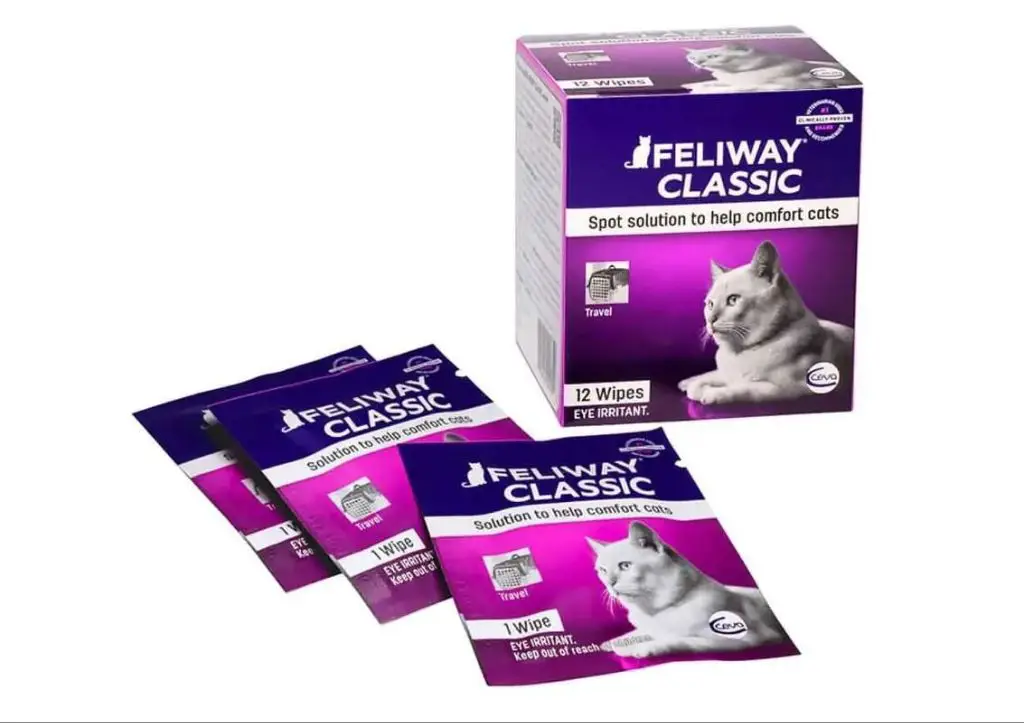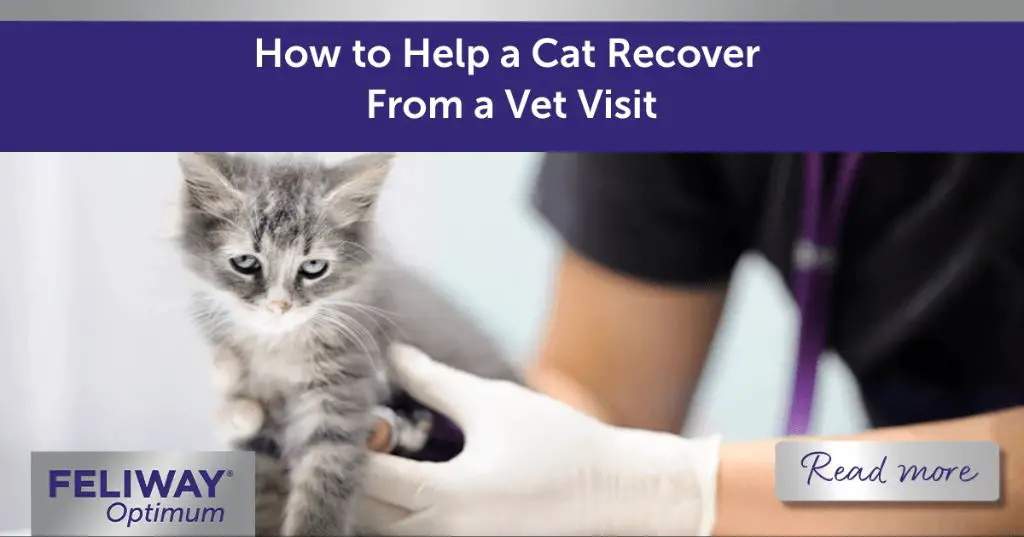What are Cat Calming Sprays?
Cat calming sprays are products designed to help relax and calm anxious or stressed cats. They typically contain pheromones, herbal extracts, essential oils, and other natural ingredients meant to have a soothing effect.
The main active ingredient in most cat calming sprays is synthetic pheromones like Feliway. Pheromones are chemicals animals produce that trigger social responses in members of the same species. Cat pheromones can signal familiarity and security to cats. Sprays containing synthetic versions of these pheromones are intended to help reassure cats and make them feel more comfortable.

In addition to pheromones, many calming sprays include herbal extracts like chamomile, lavender, and valerian to provide a soothing scent. Some also contain oils like rosemary and geranium for aromatherapy benefits. The ingredients are formulated to reduce signs of anxiety like inappropriate urination, aggression, and excessive vocalization.
Calming sprays are applied to objects and areas cats frequent like cat carriers, carpets, bedding, and scratching posts. The goal is for the pheromones and scents to have a mellowing effect and relax the cat in situations where they feel stressed.
Do They Actually Calm Cats?
There is scientific evidence that cat calming sprays, especially those containing synthetic cat pheromones like Feliway, can help reduce stress and anxiety in cats. One study published in the Journal of Feline Medicine and Surgery found the use of Feliway led to significant differences in cats’ problem behaviors compared to a placebo spray (https://pubmed.ncbi.nlm.nih.gov/26282847/). Another study in BMC Veterinary Research concluded that a pheromone diffuser had a beneficial effect in managing undesirable behaviors in cats (https://journals.sagepub.com/doi/full/10.1177/1098612X18774437).
Anecdotal reports from cat owners also suggest calming sprays can be effective. Many people say the spray helped reduce anxious behaviors like excessive meowing, scratching, and urinating outside the litter box in their cats. However, some cats seem entirely unaffected by the sprays. The effects appear dependent on the individual cat, the specific stressors, and proper use of the product.
When to Use Cat Calming Sprays
Cat calming sprays can be very helpful in stressful situations for cats like:
Traveling
Spraying a cat carrier 10-15 minutes before placing your cat inside can help reduce anxiety during travel. The pheromones from the spray provide a sense of familiarity and comfort. Studies show spraying carrier blankets reduced meowing and signs of nausea in cars and planes (Sentry Calming Spray).

Vet Visits
Vet visits can be very stressful for cats. Spraying your cat’s carrier and a blanket from home 10-15 minutes before the appointment can help lower stress hormones and keep your cat calm (PetMD). The familiar scents provide comfort in an unfamiliar environment.
Introducing New Cats
Introducing a new cat to a home with existing cats can lead to tension and stress. Spraying areas where the cats will interact helps facilitate positive introductions. The calming pheromones promote relaxation and tolerance of the new cat.
Loud Noises
Spraying spaces like a cat’s carrier or under furniture about 30 minutes before loud noises like fireworks can reduce anxiety. The pheromones create an environment of relaxation to help noise-sensitive cats stay calm.
Application Tips
When using cat calming sprays, follow these application tips for best results:
How much to use – Read the product label for dosage instructions. Typically, you’ll need 2-4 pumps or sprays per application. Don’t overapply the product, as this won’t make it more effective. Start with the minimum recommended amount.
Where to spray – Focus on areas your cat frequents like their bed, carrier, scratching posts, inside the car, or places where they have urine marked or showed signs of stress. Avoid spraying near their face.
Frequency/duration – For ongoing issues, apply the spray 1-2 times per day. Effects can last 4-5 hours for sprays with synthetic pheromones. Reapply as needed. For travel, spray carriers about 15 minutes before use. For vet visits, spray carrier right before the appointment. The calming effects are immediate but temporary.
Always read and follow label instructions. Monitor your cat’s response and adjust usage accordingly. Combining the spray with other calming techniques like routine, treats, and play can boost its effects.
https://us.feliway.com/products/feliway-classic-spray-60ml
Side Effects
While cat calming sprays contain natural ingredients and synthetic feline pheromones designed to reduce stress, some potential side effects exist. According to podcast pet products, main safety concerns with cat calming medications include side effects like vomiting, diarrhea, excessive salivation, and lack of appetite [1]. Pheromone sprays can also occasionally cause increased anxiety, restlessness, and agitation in some cats according to Triangle Animal Clinic [2]. Negative reactions seem more likely when first introducing the pheromones. Carefully read product instructions and monitor your cat’s response. Stop using if signs of distress or unwanted behaviors occur and contact your veterinarian if side effects persist.
DIY Cat Calming Sprays
Making your own natural cat calming spray at home can be easy and affordable. Many pet owners have found success using essential oils and other ingredients to create DIY solutions that help relax anxious or stressed cats without the need for synthetic pheromones.

Some popular essential oils used in DIY calming sprays for cats include:
- Lavender – Has a soothing, calming scent. Use 5-7 drops per spray bottle.
- Chamomile – Provides a mild sedative effect. Use 3-5 drops.
- Valerian – Helps cats relax and sleep. Use 2-3 drops.
- Catnip – Attracts cats and induces a temporary high/playful state. Use 1-2 drops.
In addition to essential oils, other calming ingredients to try are oat extracts, skullcap, hops, and hemp. Create your spray by combining the oils/herbs with about 8 oz of water in a clean spray bottle. Shake well before each use. Apply a light mist around your home to establish a comforting environment for your cat.[1]
Remember to always research safety before using new essential oils or ingredients for your cat. Only use high quality, food-grade oils. Start with minimal concentrations and monitor your cat’s response. Consider consulting your vet if you have any concerns.
Other Calming Options
In addition to sprays, there are other options for helping calm anxious cats:
Pheromone Diffusers/Collars
Like sprays, pheromone diffusers and collars release synthetic pheromones mimicking cats’ natural calming pheromones. Diffusers plug into outlets to disperse pheromones continuously over weeks or months. Collars worn by the cat provide a constant source of pheromones. Studies show pheromone products can help reduce stress behaviors in cats.
Medications
For severe anxiety, vets may prescribe anti-anxiety medications like fluoxetine or amitriptyline. These drugs alter brain chemicals to have a calming effect but can take weeks to start working. Side effects like lethargy and appetite changes may occur. Medication requires vet monitoring and should not be a first choice.
Environmental Changes
Sometimes a cat’s anxiety stems from its environment. Providing a quiet, comfortable space with perches, cat trees, and hiding spots can help. Limiting noise, clutter, and introductions to new people or animals prevents overstimulation. Establishing routines and consistent schedules also reduces stress for cats.
When to See the Vet
In most cases, cat calming sprays and natural methods can help reduce anxiety. However, in some situations it’s important to take your cat to the vet:
- Severe anxiety
- Ongoing inappropriate urination
If your cat is exhibiting extreme signs of anxiety or stress that do not improve with cat calming methods, make an appointment with your veterinarian. According to experts at VCA Hospitals, remaining calm and relaxed during the vet visit can help decrease your cat’s anxiety level. Speak to your cat in a soothing voice and give them treats to make the visit more positive.
Likewise, consistent inappropriate urination can indicate an underlying medical issue. According to 1st Pet Veterinary Centers, ongoing urination outside the litter box warrants a veterinary visit to rule out health problems. With a calm environment and positive vet experience, you can get to the root of the problem.
Cats vs Dogs

Cats and dogs have different needs when it comes to calming products and techniques. According to this source, dogs tend to have higher social needs than cats, so they benefit more from pheromones that provide a sense of familiarity and comfort. Cats are more solitary and territorial, so they respond better to pheromones that mark areas as safe.
Additionally, dogs show calming signals like yawning or lip licking, while stressed cats exhibit behaviors like overgrooming, urine marking, or aggression, according to this source. Calming products for dogs often use soothing chamomile, while cat calmers rely more on synthetic pheromones. The species have different sensitivities, so products tailored specifically for cats or dogs work best.
The Bottom Line
In summary, cat calming sprays can be an effective tool to help relax anxious or stressed out cats in certain situations. The key ingredients in most calming sprays are pheromones that mimic cats’ natural facial pheromones and signal safety and contentment. Research shows these pheromone sprays do work to reduce signs of anxiety in cats by an average of 50-70%, especially for short-term stressors like travel, vet visits or introductions to new pets or people. They are generally safe when used as directed, with few side effects. However, calming sprays are not a cure-all, and work best alongside other calming techniques like maintaining routines, providing enrichment, and creating safe spaces. If anxiety persists, or your cat shows signs like urinary issues or aggression, consult your vet as medications or behavior therapy may be needed.
The bottom line is cat calming sprays can be a helpful tool as part of a comprehensive approach to cat anxiety, but should be used appropriately and with reasonable expectations. Try out a reputable pheromone product, adhere to directions, and look for reduced anxious behaviors to gauge effectiveness. But also ensure your cat’s basic needs are met, and seek professional advice if problems persist. With some patience and TLC, an anxious cat can come to feel safe and comfortable once again.

